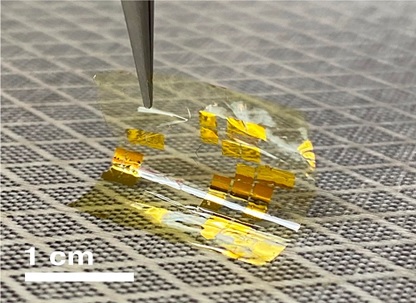New Solar Material for Ultrathin, Lightweight Solar Panels
A race is on in solar engineering to create almost impossibly thin, flexible solar panels. Researchers at Stanford University have achieved record efficiencies in a promising group of new, ultrathin photovoltaic materials. Made using transition metal dichalcogenides (TMDs), the materials absorb ultrahigh levels of the sunlight that strikes their surface compared to other solar materials. These materials provide an incredibly lightweight alternative to silicon-based solar panels.
The search for new materials is necessary because silicon – which makes up 95% of the solar market today – is much too heavy, bulky, and rigid for applications where flexibility, lightweight, and high power are preeminent, such as wearable devices and sensors or aerospace and electric vehicles. [1]

Figure 1. New Solar Material for Ultrathin, Lightweight Solar Panels
Figure 1 shows it is encouraging to see the progress in the development of efficient and powerful solar cells. Materials exhibiting ferroelectricity, flexibility and impermeability are some of the few discovered recently.
Contributing to the list is a new photovoltaic material called Transition Metal Dichalcogenides or TMDs developed by researchers at Stanford University that promises to absorb high levels of sunlight and consequently supply a generous amount of power.
“Imagine an autonomous drone that powers itself with a solar array atop its wing that is 15 times thinner than a piece of paper,” said Koosha Nassiri Nazif, a doctoral scholar in electrical engineering at Stanford.
A promising future
The many advantages of TMDs are countered by certain downsides, mostly in the engineering intricacies of mass production. The process of transferring an ultrathin layer of TMD to a flexible, supporting material often damages the TMD layer.
Alwin Daus, who was co-lead author on the study with Nassiri Nazif, devised the transfer process that affixes the thin TMD solar arrays to the flexible substrate. He said this technical challenge was considerable. One step involved transferring the layer of atomically thin graphene onto a flexible substrate that is just a few microns thick, explained Daus, who was a postdoctoral scholar in Eric Pop’s research group at Stanford when the research was conducted. He is now a senior researcher at RWTH Aachen University in Germany.
This intricate process results in the TMD being fully embedded in the flexible substrate leading to greater durability. The researchers tested the flexibility and robustness of their devices by bending them around a metal cylinder less than a third of an inch thick.
“Powerful, flexible and durable, TMDs are a promising new direction in solar technology,” Nassiri Nazif concluded. [2]
References:
- https://www.inceptivemind.com/stanford-solar-materials-usher-ultrathin-lightweight-solar-panel/22494/
- https://news.stanford.edu/2021/12/14/new-materials-deliver-ultrathin-solar-panel/
- https://www.electronicsforu.com/news/whats-new/new-solar-material-for-ultrathin-lightweight-solar-panels
Cite this article:
Thanusri swetha J (2022), New Solar Material for Ultrathin, Lightweight Solar Panels, pp. 83

